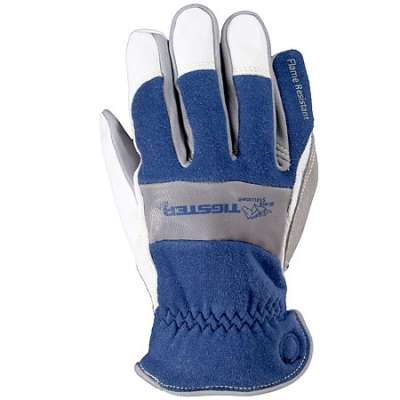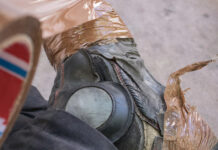More than any other part of our body, our hands are the most likely to come in contact with hazardous materials or conditions on the job. Most work related accidents involving hands and arms could be classified under four main hazard categories: chemicals, abrasions, cutting, and heat. There are various work and safety gloves available that can protect workers from any of these individual hazards or any combination thereof. Many companies use some type of chemicals in their workplace. Workplaces also expose your hands to the risk of burns or cuts. As a result of these risks it is crucial that you work with your employer to know the risks of the job and take the proper procedures to protect yourself.
Different aspects of the job need to be examined in order to determine what types of risks are present. The environmental conditions present need to be considered. The time it takes to complete the task needs to be considered as well. There needs to be an accurate estimation of the potential hazards for the conditions. On the individual level you need to determine how much dexterity is required for the task as well as the frequency in which it is performed. Once all of these aspects are accurately analyzed, you can determine what type of protection needs to be in place.
Careful attention must be given to protecting your hands when working with tools and machinery as glove safety guidelines have been set by for various positions. Power tools and machinery must have guards installed or incorporated into their design that prevent the hands from contacting the point of operation, power train, or other moving parts. To protect hands from injury due to contact with moving parts, it is important to ensure that the guards are always in place and used. If the guards are not there, you shouldn’t use the machine. You should always lockout machines or tools and disconnect the power before making repairs. Do not wear gloves around moving machinery or parts, such as drill presses, mills, lathes and grinders.
Skin contact is a potential source of exposure to toxic materials; it is important that the proper steps be taken to prevent such contact. For chemical hazards, the toxic properties of the substances must be determined–particularly the ability of the chemical to cause local effects on the skin and/or to pass through the skin and cause systemic effects. For mixtures and formulated products (unless specific test data are available), a glove should be selected on the basis of the chemical component with the shortest breakthrough time. It is possible for solvents to carry active ingredients through polymeric materials. There are two ways a glove must be considered. First you must look at the permeation rate. This rate measures the length of time it takes a given material (glove) to become saturated by the chemical absorption. The second is the breakthrough or penetration rate, which measures the speed with which a given chemical breaks through the layer(s) of the glove to contact the skin. These two factors will allow you to determine the right kind of protection needed. It is important to select the most appropriate glove for a particular application and to determine how long it can be worn, and whether it can be reused.
Chemicals will eventually soak through or “permeate” most glove materials rendering them unsafe. You need to determine the specific type of glove material that should be worn for a particular chemical. Standard test procedures should assess these performance characteristics. Before purchasing gloves, the employer should request documentation from the manufacturer that the gloves meet the appropriate test standards for the hazards anticipated. It is important to read instructions and warnings on chemical container labels and MSDs before working with any chemical. Recommended glove types are often listed in the section for personal protective equipment.
Disposable gloves, usually made of lightweight plastic, can help guard against mild irritants. Fabric gloves, made of cotton or fabric blends, generally are used to improve grip when handling slippery objects. They also help insulate hands from mild heat or cold. Leather gloves guard against injuries from sparks or scraping against rough surfaces or as a combination with an insulated liner when working with electricity. Metal mesh gloves protect hands from accidental cuts and scratches. Persons working with cutting tools or other sharp instruments most commonly use them. Aluminized gloves are made of aluminized fabric and are designed to insulate hands from intense heat. When working with molten materials these are often used. Chemical resistance gloves may be made of rubber, neoprene, polyvinyl alcohol or vinyl, etc. These gloves protect hands from corrosives, oils, and solvents.
The glove chart below may serve as a guide to the different types of glove materials and the chemicals they can be used against. When selecting chemical resistance gloves, be sure to consult the manufacturers’ recommendations, especially if the gloved hand will be immersed in the chemical. It is also extremely important that you find the right fit for your gloves. Gloves that do not fit properly may leave you with less than optimal protection, so make sure you have the proper fit for your gloves.
Glove Chart
| Type | Advantages | Disadvantages | Use Against |
| Natural rubber | Low cost, good physical properties, dexterity | Poor vs. oils, greases, organics. Frequently imported; may be poor quality | Bases, alcohols, dilute water solutions; fair vs. aldehydes, ketones. |
| Natural rubber blends | Low cost, dexterity, better chemical resistance than natural rubber vs. some chemicals | Physical properties frequently inferior to natural rubber | Same as natural rubber |
| Polyvinyl chloride (PVC) | Low cost, very good physical properties, medium cost, medium chemical resistance | Plasticizers can be stripped; frequently imported may be poor quality | Strong acids and bases, salts, other water solutions, alcohols |
| Neoprene | Medium cost, medium chemical resistance, medium physical properties | NA | Oxidizing acids, anilines, phenol, glycol ethers |
| Nitrile | Low cost, excellent physical properties, dexterity | Poor vs. benzene, methylene chloride, trichloroethylene, many ketones | Oils, greases, aliphatic chemicals, xylene, perchloroethylene, trichloroethane; fair vs. toluene |
| Butyl | Specialty glove, polar organics | Expensive, poor vs. hydrocarbons, chlorinated solvents | Glycol ethers, ketones, esters |
| Polyvinyl alcohol (PVA) | Specialty glove, resists a very broad range of organics, good physical properties | Very expensive, water sensitive, poor vs. light alcohols | Aliphatics, aromatics, chlorinated solvents, ketones (except acetone), esters, ethers |
| Fluoro- elastomer (Viton) | Specialty glove, organic solvents | Extremely expensive, poor physical properties, poor vs. some ketones, esters, amines | Aromatics, chlorinated solvents, also aliphatics and alcohols |
| Norfoil (Silver Shield) | Excellent chemical resistance | Poor fit, easily punctures, poor grip, stiff | Use for Hazmat work |




